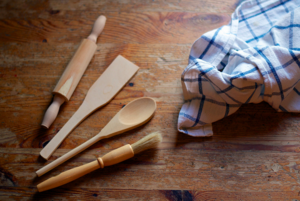
In order to preserve wooden kitchenware for the longer term, it's essential to take some basic care precautions. This article provides an outline of the basic care routine for such items as wooden spoons, wooden spatulas and wooden cutting boards.
Using wooden kitchenware[edit | edit source]
Things to pay attention to when using wooden kitchenware include:
- Be aware that some foods will stain wooden kitchenware, especially if the wood is raw. Turmeric is a good example, as it will stain raw wood yellow.
- Do not place wooden items into bladed appliances, such as blenders and food processors. When working, the blades will chop the wood, and as well as damaging the item, there is a risk of splinters flying out and injuring you.
- Expect wooden cutting boards to be scratched and cut, as knife blades will impact the surface. This is considered normal for cutting boards but eventually may require the board to be sanded back to prevent too many ridges.
If wooden kitchenware tools such as spoons and spatulas get splinters, often a simple sanding will improve them enough to keep using them.
Cleaning wooden kitchenware[edit | edit source]
When cleaning wooden kitchenware, the following care instructions are vital:
- Go easy on the soap.
- Do not place in the dishwasher; wooden kitchenware is not dishwasher safe.
- Do not immerse wooden kitchenware in the dishwater in the kitchen sink. Wooden kitchenware should be damp-wiped clean, not immersed in water.
- A few times a year, rub the wooden kitchenware with walnut oil (or grapeseed or olive oils).
Examples of wooden kitchenware[edit | edit source]
- Wooden spoons
- Wooden spatulas
- Wooden cutting boards
- Wooden mortar and pestle
- Wooden rolling pins
- Wooden pastry brushes
Recycling unwanted wooden kitchenware[edit | edit source]
Some ways to use wooden kitchenware that is no longer useful for the kitchen include:
- Turn spoons and spatulas into play items such as dolls and puppets
- Use spoons, etc., as plant stakes and markers
- Compost thinner wooden items
- Cutting boards can be used as stands, mini tabletops/trays for outdoor eating, sorting surfaces for tools, lids, etc. Paint with chalkboard paint to make a small chalkboard. Turn into a notepad holder, a picture holder or a key holder. Transform it into a shelf. There are endless possibilities.[1]
Tips[edit | edit source]
- Note that many wooden kitchenware items can also come in plastic, silicone, metal and glass forms. These require different care methods.
See also[edit | edit source]
- organic care of wooden spoons, cutting boards, etc. at richsoil.com
- forum on care of food grade wood stuff at permies.com